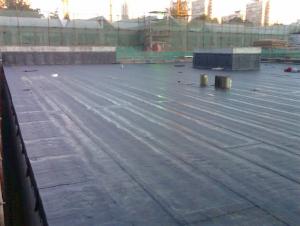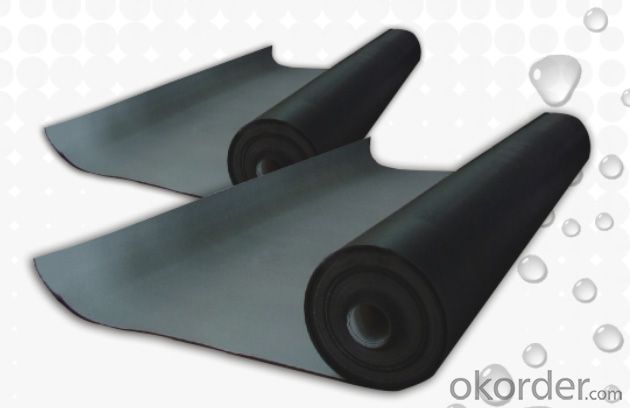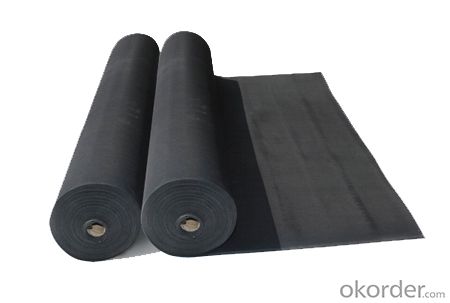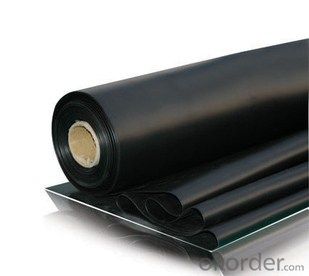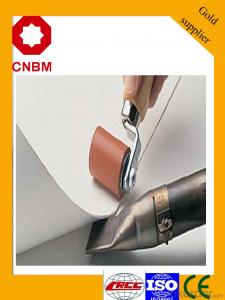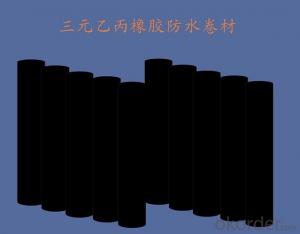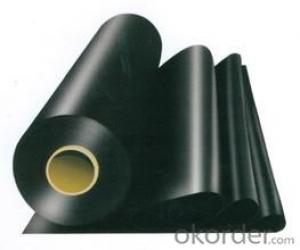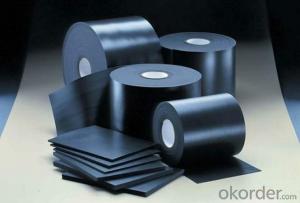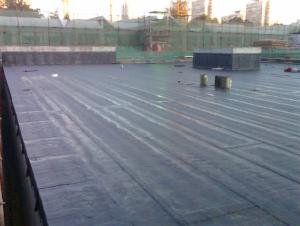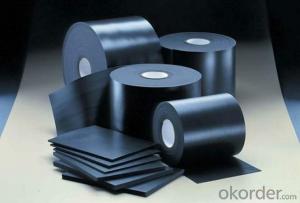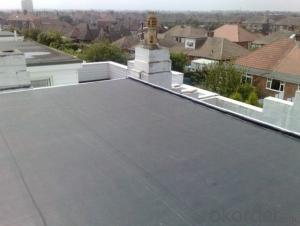EPDM Coiled Rubber Waterproof Membrane for Roofing Area
- Loading Port:
- Shanghai
- Payment Terms:
- TT OR LC
- Min Order Qty:
- 50000 m²
- Supply Capability:
- 5000000 m²/month
OKorder Service Pledge
OKorder Financial Service
You Might Also Like
EPDM Coiled Rubber Waterproof Membrane for Roofing Area
Description Of EPDM Coiled Rubber Waterproof Membrane for Roofing Area:
•EPDM waterproof sheet has excellent anti-ozone-aging performance, able to resist ultraviolet light and corrosion of many chemical corrosive materials in the atmosphere
•It has high tensile strength, high ductility and strong retractility, it has excellent crack resistance, able to effect waterproof function even with tiny vibration of buildings.
• Excellent resistance to ozone, oxidation and sunlight.
• Resistance to chemicals; resistant to most inorganic products.
Main Features of EPDM Coiled Rubber Waterproof Membrane for Roofing Area:
A.Polyester based SBS Modified Bitumen Waterproofing Membrane
a. Strong impermeability
b. High tensile strength, elongation, ability to adapt the grassroots shrinkage deformation and cracking
c. Puncture-resistant, broken resistant, tear-resistant
d. The corrosion resistance, resistance to mildew, weathering good
e. Construction convenient, hot-melt can be operated Four Seasons Construction, reliable joints
Specifications of EPDM Coiled Rubber Waterproof Membrane for Roofing Area:
| Material | EPDM Rubber |
| Size | 1.2m (width)*20m (length) or customized, weldable type 2.05m or 4m width |
| Thick | 1.2mm, 1.5mm, 2.0mm |
| Type | Vulcanized & Weldable |
| Pattern | Non-reinforced (homogeneous) |
| Certificate | ISO9001/14001 |
Applications of EPDM Coiled Rubber Waterproof Membrane for Roofing Area:
1. The substratum should be smooth, dry, clean, which can not have loosing and peeling phenomena.
2. Before application, clean up the basic level and eradicate the impurities.
3. Spread out the membrane on the substratum to loose sheet's stress. Use adhesive-glue to paint the substratum and the surface of membrane. When the adhesive is not sticky to hands, pave and press smoothly.
4. When pave the second volume of membrane, extrude 100mm of the edge of overlap of the first roll and do not paint with the adhesive. Pave the membrane on the substratum according to step so as to finish the whole pavement. When paving, do not tighten the waterproof membrane violently.
5. After that, use the special solvent to scrub the overlap joint. When it becomes fully dry , use the sheet glue to paint the both sides of the joint. Paint it again when it gets completely dry. Till the adhesive is not sticky to hands, press it smoothly and solidly.
6. Pay attention to fire prevention during application. Basement construction site shall be equipped with ventilation facilities



IMages of EPDM Coiled Rubber Waterproof Membrane for Roofing Area:




FAQ of EPDM Coiled Rubber Waterproof Membrane for Roofing Area:
1. What are we supplying?
We are specialized in producing Colorful Asphalt Roof Shingle, SBS/APP modified bitumen waterproof membrane, Self adhesive bitumen waterproof membrane, PVC waterproofing membrane, EPDM rubber roofing membrane, Single Component Polyurethane Waterproof Coating, and Spray Polyurea Waterproof Coating
.
2. How Many years experience do we have?
We have been exported to more than 20 countries in the past 15 years.
3. How long do we usually reply your request?
We always reply our customer within 24 hours.
- Q: Can a waterproofing membrane be used for a dam?
- Yes, a waterproofing membrane can be used for a dam. It can effectively prevent water leakage and seepage, ensuring the structural integrity of the dam and its ability to hold and control water.
- Q: Can a waterproofing membrane be used in swimming pools or water features?
- Swimming pools or water features can benefit from the use of a waterproofing membrane. This type of membrane is commonly employed in these scenarios to establish a barrier between the water and the surrounding structure. By doing so, it prevents any water leakage and structural damage, ultimately ensuring the swimming pool or water feature's longevity and durability. Typically, the membrane is applied to the structure's surface and can be composed of various materials like rubber, PVC, or bitumen. It is imperative to select a membrane specifically designed for underwater applications to guarantee its effectiveness in providing a watertight seal. Furthermore, proper installation and regular maintenance of the waterproofing membrane are vital to uphold its long-term performance.
- Q: Are waterproofing membranes resistant to sulfuric acid exposure?
- Yes, waterproofing membranes are generally resistant to sulfuric acid exposure. These membranes are designed to provide a barrier against water and other chemicals, including sulfuric acid. However, the level of resistance may vary depending on the specific type and quality of the membrane. It is advisable to consult with manufacturers or experts to ensure the membrane's compatibility with sulfuric acid exposure in specific applications.
- Q: Is a waterproofing membrane resistant to hydrostatic pressure?
- Yes, a waterproofing membrane is resistant to hydrostatic pressure. A waterproofing membrane is designed to create a barrier against water and prevent it from penetrating through the foundation or structure. It is specifically engineered to withstand and resist the pressure exerted by water in soil or other external sources. This resistance to hydrostatic pressure is achieved through the use of durable and impermeable materials, such as rubberized asphalt or polyethylene, that are able to withstand the force of water pushing against them. The membrane is also installed in such a way that it creates a continuous and seamless layer, further enhancing its ability to resist hydrostatic pressure. Overall, a properly installed waterproofing membrane can effectively protect a structure from water intrusion, even under significant hydrostatic pressure.
- Q: Are waterproofing membranes resistant to sulfuric acid exposure?
- Waterproofing membranes typically do not possess resistance against sulfuric acid exposure. Sulfuric acid, being an immensely corrosive substance, has the potential to inflict substantial harm to various materials, including waterproofing membranes. The membrane's deterioration can occur as a result of sulfuric acid's highly acidic properties, ultimately causing its failure. Hence, if there exists a chance of sulfuric acid exposure, it becomes crucial to employ materials that are explicitly engineered to endure such corrosive substances.
- Q: Can a waterproofing membrane be used on gypsum board surfaces?
- Yes, a waterproofing membrane can be used on gypsum board surfaces. Gypsum board, also known as drywall, is a common material used in interior construction. While it is not inherently waterproof, applying a waterproofing membrane can help protect the gypsum board from moisture damage. A waterproofing membrane is a thin layer of material that is applied to the surface of the gypsum board. It forms a barrier that prevents water from seeping into the board and causing it to deteriorate or mold. It can be used in areas where moisture is present, such as bathrooms, kitchens, laundry rooms, or basements. Before applying a waterproofing membrane, it is important to prepare the gypsum board surface properly. This may involve cleaning the surface, patching any holes or cracks, and ensuring the board is dry and free of dust. Once the surface is ready, the waterproofing membrane can be applied according to the manufacturer's instructions. It is worth noting that while a waterproofing membrane can provide some protection against moisture, it is not a guarantee against water damage. It is always important to address the source of water intrusion and ensure proper drainage and ventilation in any area prone to moisture. Additionally, it is recommended to consult with a professional or follow the manufacturer's recommendations when choosing and applying a waterproofing membrane to gypsum board surfaces.
- Q: Can waterproofing membranes be used in cold climates?
- Yes, waterproofing membranes can be used in cold climates. In fact, they are specifically designed to provide protection against moisture and water infiltration in various weather conditions, including cold temperatures. These membranes are typically made from durable, flexible materials that can withstand freezing temperatures without cracking or deteriorating. Additionally, some waterproofing membranes come with added features like thermal insulation, which helps to prevent heat loss and maintain a comfortable indoor environment in cold climates. Overall, waterproofing membranes are an effective solution for ensuring the integrity and longevity of structures in cold weather conditions.
- Q: Can waterproofing membranes be used on underground structures?
- Yes, waterproofing membranes can be used on underground structures.
- Q: Are waterproofing membranes resistant to mold and mildew?
- Yes, waterproofing membranes are generally resistant to mold and mildew. These membranes are designed to create a barrier against moisture, preventing it from seeping into the structure and causing mold and mildew growth. Waterproofing membranes are often made from materials such as rubber, PVC, or bitumen, which are not conducive to mold and mildew growth. Additionally, these membranes are installed in a way that ensures proper drainage and ventilation, further reducing the chances of mold and mildew formation. However, it is important to note that while waterproofing membranes can greatly reduce the risk of mold and mildew, they are not foolproof. It is still essential to maintain proper ventilation and address any water leaks or damage promptly to prevent mold and mildew growth.
- Q: Can a waterproofing membrane be used on both interior and exterior walls?
- Yes, a waterproofing membrane can be used on both interior and exterior walls. Waterproofing membranes are designed to prevent the penetration of water or moisture into the walls, regardless of whether they are located on the interior or exterior of a building. These membranes are typically made from materials such as rubber, modified bitumen, or liquid-applied coatings, and they provide an effective barrier against water infiltration. By applying a waterproofing membrane on both interior and exterior walls, you can ensure the long-term protection of your building from water damage, mold growth, and other moisture-related issues.
Send your message to us
EPDM Coiled Rubber Waterproof Membrane for Roofing Area
- Loading Port:
- Shanghai
- Payment Terms:
- TT OR LC
- Min Order Qty:
- 50000 m²
- Supply Capability:
- 5000000 m²/month
OKorder Service Pledge
OKorder Financial Service
Similar products
Hot products
Hot Searches
Related keywords
